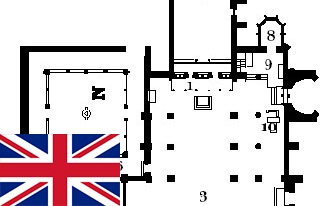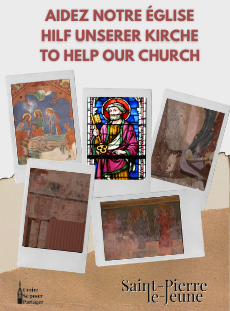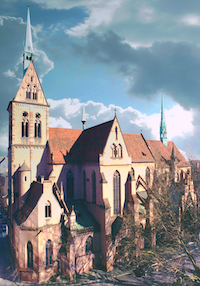
HISTORY OF THE CHURCH :
Three churches have been built in succession on the same site. In the early Middle Ages a small church was dedicated to St Colomban – or possibly St Columba ; the funeral vault that can still be seen beneath the outer south aisle may have been part of that church.. In 1031 work was begun on a romanesque church for a chapter of canons; the cloisters and the lower parts of the bell tower are all that remain. On the occasion of its consecration, probably by Pope Leo IX, in 1053 the church was given the name of the name of New St Peter's (Jung Sankt Peter, literally “ Young St Peter's “), to distinguish it from another church dedicated to St Peter, which was renamed Old St Peter’s.
The present church, begun in the second half of the 13th century with the choir, was consecrated in 1320. Chapels were added in the 14th and 15th centuries. From 1524 protestant worship was authorised in the church.. In 1682 Louis gave the choir to the Catholic parish ; a dividing wall, supported by the rood screen, served to separate the choir from the nave. It was not removed until 1898 when, after the construction of the Catholic church of of New St Peter's, the whole church once again became protestant. Major work of restoration was then undertaken: old frescoes were revealed and restored.
From your position beneath the large chandelier you can see:
In front of you, to the east, the gothic Rood Screen (1) with five arches, supporting the Silbermann organ of 1780 (frequently used in concerts), restored and extended in 1953 and 1966. On the rood-screen there are oil paintings depicting the four Evangelists, painted by Engelhardt in 1620. Beneath the rood-screen to the left, is a 13th-century statue of a monk holding a cup (“piscina”). Beyond the organ is the choir, slightly lower than the nave, dating from the end of the 13th century.
Behind you the west end of the nave is decorated with a fresco (2) depicting the storm on the Sea of Galilee, based on Giotto’s “Navicella” in St Peter’s Rome. The eight angels below it represent the Beatitudes.The nave, consecrated in 1320, is made up of three bays with cross-ribbed vaulting between the rood-screen and the transept, and one bay to the west of the transept. The square pillars with chamfered corners reach to the base of the vaults. The transept (3) was displaced to the west, probably in order to preserve the romanesque cloisters; it is the same height as the nave.
The north, west and south walls are decorated with frescoes, radically restored around 1900; on the south side they trace the genealogy of Jesus Christ, on the west and north sides they depict episodes from the Passion of Christ.
The windows of the nave date from the restoration of 1900; at the bottom they show the coats of arms of the families whose members were canons of St Pierre le Jeune and many of whom are buried in the church. There are approximately 70 tombstones and epitaphs in the church and the cloisters.
NOW BEGIN YOUR VISIT :
- The Zorn chapel (4) dating from the 14th century was the funeral chapel of the Zorn family. Note the coats of arms of the different branches of the Zorn family on the vault: against the pillar the memorial stone of Adam Zorn (15th century) captain of the militia. The ribs of the vault rest on slender consoles. On the north wall is a monument in memory of Pastor Friedrich Horning (d. 1882), the initiator of the Lutheran revival in Strasbourg.
- In St Nicholas’ Chapel (5), dating from the 14th century, are a pulpit made in 1782, and a baroque altar which were used in the central nave until the restoration of 1900.
- The cloisters (6) are made up of three 11th-century romanesque galleries and a 14th-century gothic gallery. Despite considerable restoration they can be considered the oldest surviving cloisters north of the Alps. Note in the west gallery a pillar decorated with four carved heads. There are also numerous tombstones and epitaphs from the period between the 14th and 18th centuries. The buildings around the cloisters originally housed the Chapter of St Pierre le Jeune (they were secularised and sold after the dissolution of the Chapter during the French Revolution).
- Now go back inside the church and walk along the wall of the north aisle which is also the wall of the cloisters. The 14th-century frescoes, repainted around 1900, depict the Passion and Resurrection of Christ.
- Pass beneath the brightly coloured vaults of the rood-screen (1) and enter the choir which dates from the 13th century. The eight ribs at the east end of the vault converge in a single keystone. The baroque panelling and the pulpit were added around the middle of the 18th century. The central panel of the altar-piece (7) dates from 1518. Behind the altar is the apse chapel, rebuilt around 1900, and now used as a baptistery; the statue of the angel (c. 1900) is the work of the sculptor Ferdinand Riedel.
- Now leave the choir passing again beneath the rood-screen and take the steps to the left to enter the Chapel of the Trinity (8), a fine chapel in the flamboyant gothic style, completed in 1491 by Hans Hammer (who also carved the pulpit of the Cathedral). Note the details of the sculpture, the pedestals and canopies of the statues (for the most part modern). The baptismal fonts are 15th century.
- In front of the Chapel of the Trinity note the roof bosses (9) decorated with heads, the elaborately carved brackets which support the ribs of the vault, and two funeral monuments: that of Bishop Hetzilo (d. 1065) to the right by the steps, and that of Prior Goetz von Grostein (d. 1376) to the left.
- Pass in front of the steps leading to the main door in order to go down into the hypogeum (10) or funeral vault (4th –10th century).
- Now go along the south wall to return to the entrance to the church. Before leaving you will see on the west wall of the south aisle a remarkable fresco (11) showing the nations of Europe marching towards the cross.
- Behind this fresco is St John’s Chapel (12), of particular interest for its interior buttresses.
The church of St Pierre le Jeune, classified as an historical monument in 1848, is a mine of archaeological, artistic and historical inspiration. It bears witness to the faith of countless generations. Should you wish to learn more about this church, you can obtain booklets and postcards at the bookstall.













